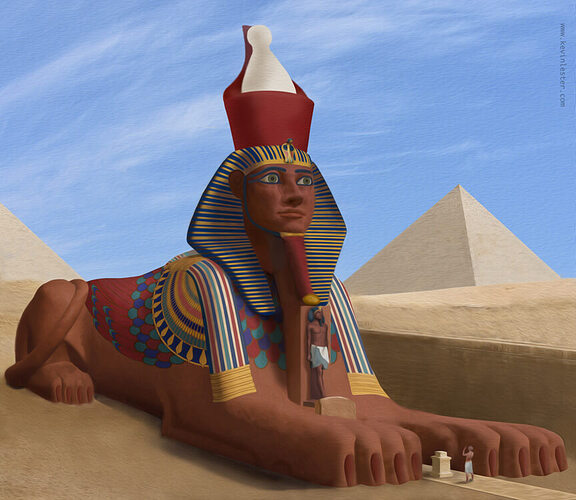There have many, many books written about the Sphinx and I am not even trying to do the ancient relic justice.
Any mistakes are mine.
The Sphinx facts and legends
A sphinx (or sphynx) is essentially a creature with the body of a lion and the head of a human. It is a prominent mythological figure in Egyptian, Asian, and Greek mythology.
The gigantic limestone statue’s history is unclear as to what regard Egyptians held the Great Sphinx during the Old Kingdom (c. 2613-2181 B.C.), as there are few texts that discuss the statue. However, Khafre associated himself with the god Horus and the Great Sphinx may have been known as Harmakhet (“Horus on the Horizon”), as it was during the New Kingdom (1570-1069 B.C.).
Whatever the case, the statue began to fade into the desert background at the end of the Old Kingdom, at which point it was ignored for centuries.
Inscriptions on a pink granite slab between the Great Sphinx’s paws tell the story of how the statue was saved from the sands of time. Prince Thutmose, son of Amenhotep II, fell asleep near the Sphinx, the story goes. In Thutmose’s dream, the statue, calling itself Harmakhet, complained about its state of disarray and made a deal with the young prince: It would help him become pharaoh if he cleared away the sand from the statue and restored it.
Whether or not the dream actually occurred is unknown, but when the prince did, in fact, become Pharaoh Thutmose IV, he introduced a Sphinx-worshipping cult to his people. Statues, paintings, and reliefs of the figure popped up across the country and the sphinx became a symbol of royalty and the power of the sun.
Did you know, the head and face of the Sphinx are strikingly similar to a life-size statue of Khafre that French archaeologist Auguste Mariette found in the Valley Temple—the ruins of a building situated adjacent to the Great Sphinx—in the mid-1800s? Or that residues of red pigments on the face of the Sphinx suggest the statue may have been painted.
It is a prominent mythological figure in Egyptian, Asian, and Greek mythology.
In ancient Egypt, the sphinx was a spiritual guardian and most often depicted as male with a pharaoh headdress — as is the Great Sphinx —and figures of the creatures were often included in tomb and temple complexes.
What Egyptians called the Great Sphinx during its prime remains a riddle, because the word sphinx originates from Greek mythology some 2,000 years after the statue was built.
The Great Sphinx was eventually forgotten again. Its body suffered from erosion and its face became damaged by time.
Though some stories claim Napoleon‘s troops shot off the statue’s nose with a cannon when they arrived in Egypt in 1798, 18th-century drawings suggest the nose went missing long before then. More likely, the nose was purposely destroyed by a Sufi Muslim in the 15th century to protest idolatry. Part of the Sphinx’s royal cobra emblem from its headdress and sacred beard have also broken off, the latter of which is now displayed in the British Museum.
The Sphinx was actually buried in sand up to its shoulders until the early 1800s, when a Genoese adventurer named Capt. Giovanni Battista Caviglia attempted (and ultimately failed) to dig out the statue with a team of 160 men.
Mariette managed to clear some of the sand from around the sculpture and Baraize made another large excavation push in the 19th and 20th centuries. But it wasn’t until the late 1930s that Egyptian archaeologist Selim Hassan was able to finally free the creature from its sandy tomb.
Today, the Sphinx is continuing to deteriorate thanks to wind, humidity, and pollution. Restoration efforts have been ongoing since the mid-1900s, some of which failed and ultimately caused more damage to the Sphinx.
In 2007, authorities learned that the local water table under the statue was rising due to sewage being dumped in a nearby canal. The moisture ultimately spread through the porous limestone of the structure, causing the rock to crumble and break away in large flakes in some cases. Authorities installed pumps close to the Great Sphinx, diverting the groundwater and saving the relic from further destruction.
Researchers estimate that it would have taken 100 people 3 years to carve the Great Sphinx out of a single mass of limestone. But there’s some evidence that these workers may have suddenly quit before fully finishing the sphinx and temple complex, such as partially quarried bedrock and remnants of a workman’s lunch and tool kit.
Over the years, researchers have put forth many other theories for the Great Sphinx’s origins, though most are refuted by mainstream Egyptologists.
Some theories suggest the face of the sphinx actually resembles Khufu and, therefore, Khufu built the structure. Alternatively, Pharaoh Djedefre—Khafre’s older half-brother and Khufu’s other son—built the Great Sphinx in commemoration of his father.
Other theories hold that the statue depicts Amenemhat II (around 1929 to 1895 B.C.) based on the style of the stripes on the sphinx’s head cloth.
Some scientists also contend that the Great Sphinx is far older than is widely believed, based on the potential age of the causeway or various patterns of erosion of the statue.
The legendary Riddle of the Sphinx actually came from Greek mythology.
Fact or legend, the Sphinx has fascinated people for many millennia
and it seems will continue to do so long into the future.
Sources
Sphinx-lined road unearthed in Egypt; PhysOrg.
The Great Sphinx of Giza; Ancient History Encyclopedia.
The Mystery of the Great Sphinx; Ancient History Encyclopedia.
Old Kingdom of Egypt; Ancient History Encyclopedia.
What happened to the Sphinx’s nose?; Smithsonian.
Saving the Sphinx; PBS/NOVA.
Citation Information
Article Title
The Sphinx
Author
History.com Editors
Website Name; HISTORY
URL; The Sphinx - HISTORY
Access Date
November 18, 2021
Publisher
A&E Television Networks
Thanks for reading.
Garnet, Blessed by Dragons
